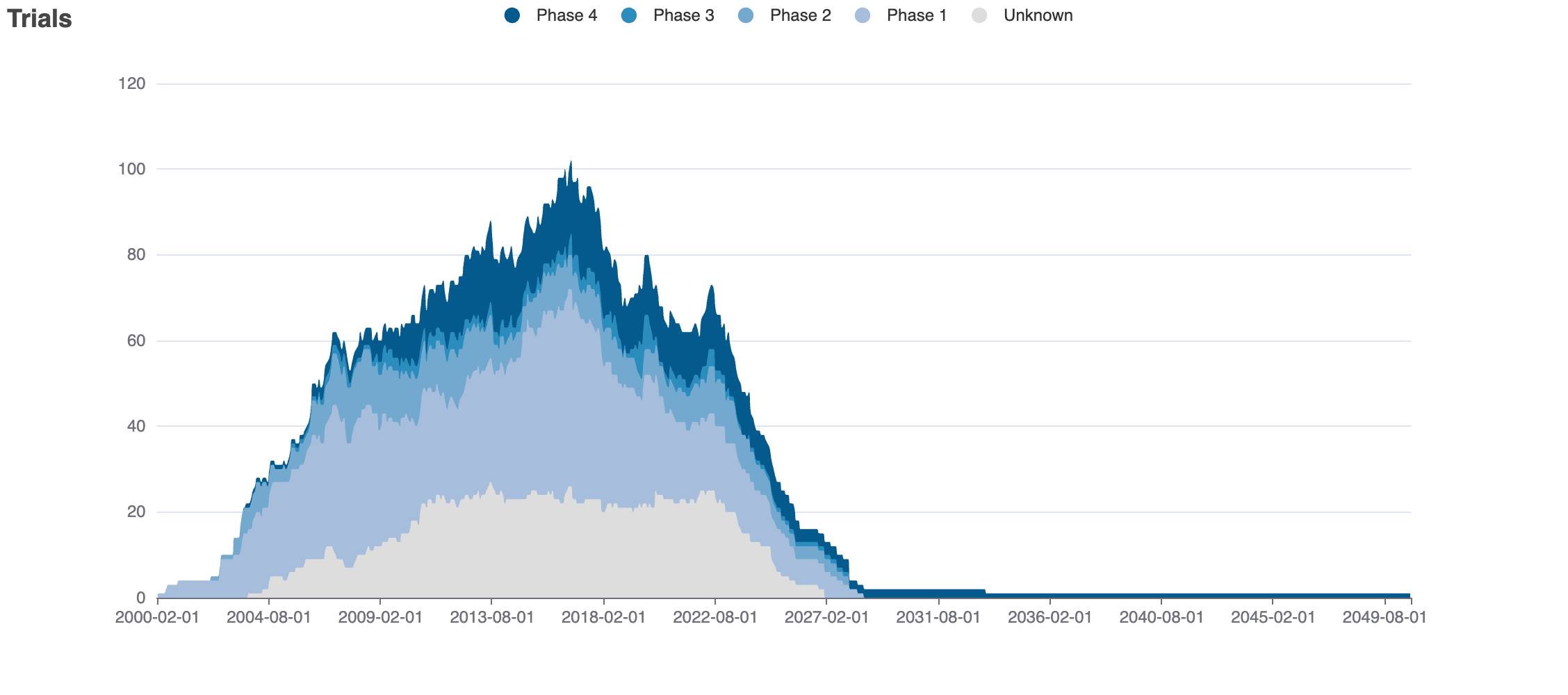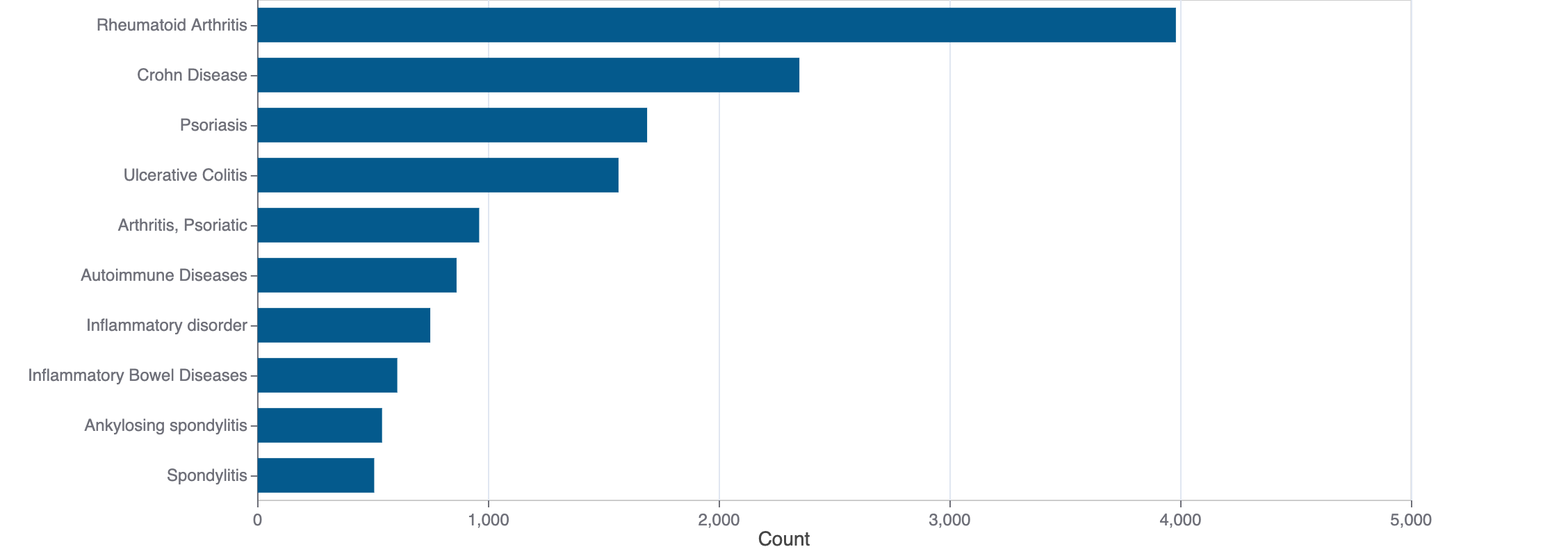Tetrodotoxin
Tetrodotoxin is a small molecule pharmaceutical. It is currently being investigated in clinical studies. It is known to target sodium channel protein type 2 subunit alpha, sodium channel protein type 5 subunit alpha, sodium channel protein type 4 subunit alpha, sodium channel protein type 10 subunit alpha, sodium channel protein type 8 subunit alpha, sodium channel protein type 11 subunit alpha, sodium channel protein type 1 subunit alpha, sodium channel protein type 3 subunit alpha, and sodium channel protein type 9 subunit alpha.
Download report
Favorite
Commercial
Therapeutic Areas
No data
Trade Name
FDA
EMA
No data
Drug Products
FDA
EMA
New Drug Application (NDA)
New Drug Application (NDA)
Abbreviated New Drug Application (ANDA)
Abbreviated New Drug Application (ANDA)
No data
Labels
FDA
EMA
No data
Indications
FDA
EMA
No data
Agency Specific
FDA
EMA
No data
Patent Expiration
No data
ATC Codes
No data
HCPCS
No data
Clinical
Clinical Trials
6 clinical trials
View more details

Mock data
Subscribe for the real data
Subscribe for the real data
Indications Phases 4
No data
Indications Phases 3
Indication | MeSH | Ontology | ICD-10 | Ph 1 | Ph 2 | Ph 3 | Ph 4 | Other | Total |
|---|---|---|---|---|---|---|---|---|---|
| Pain | D010146 | EFO_0003843 | R52 | — | 1 | 2 | — | — | 3 |
| Neoplasms | D009369 | C80 | — | — | 2 | — | — | 2 |
Indications Phases 2
Indication | MeSH | Ontology | ICD-10 | Ph 1 | Ph 2 | Ph 3 | Ph 4 | Other | Total |
|---|---|---|---|---|---|---|---|---|---|
| Neuralgia | D009437 | EFO_0009430 | — | 2 | — | — | — | 2 | |
| Peripheral nervous system diseases | D010523 | G64 | — | 1 | — | — | — | 1 |
Indications Phases 1
Indication | MeSH | Ontology | ICD-10 | Ph 1 | Ph 2 | Ph 3 | Ph 4 | Other | Total |
|---|---|---|---|---|---|---|---|---|---|
| Healthy volunteers/patients | — | 1 | — | — | — | — | 1 |
Indications Without Phase
No data
Epidemiology
Epidemiological information for investigational and approved indications
View more details
Drug
General
| Drug common name | TETRODOTOXIN |
| INN | tetrodotoxin |
| Description | Tetrodotoxin (TTX) is a potent neurotoxin. Its name derives from Tetraodontiformes, an order that includes pufferfish, porcupinefish, ocean sunfish, and triggerfish; several of these species carry the toxin. Although tetrodotoxin was discovered in these fish and found in several other animals (e.g., in blue-ringed octopuses, rough-skinned newts, and moon snails), it is actually produced by certain infecting or symbiotic bacteria like Pseudoalteromonas, Pseudomonas, and Vibrio as well as other species found in animals.
|
| Classification | Small molecule |
| Drug class | fluoroquinolone derivatives, nonantibacterial indication (e.g., antineoplastic antibiotics) |
| Image (chem structure or protein) | |
| Structure (InChI/SMILES or Protein Sequence) | NC1=N[C@H](O)[C@H]2[C@H]3O[C@]4(O)O[C@@H]([C@@H](O)[C@@]2(N1)[C@@H]4O)[C@]3(O)CO |
Identifiers
| PDB | — |
| CAS-ID | 4368-28-9 |
| RxCUI | — |
| ChEMBL ID | CHEMBL507974 |
| ChEBI ID | — |
| PubChem CID | 11174599 |
| DrugBank | — |
| UNII ID | 3KUM2721U9 (ChemIDplus, GSRS) |
Target
Agency Approved
No data
Alternate
SCN2A
SCN2A
SCN5A
SCN5A
SCN4A
SCN4A
SCN10A
SCN10A
SCN8A
SCN8A
SCN11A
SCN11A
SCN1A
SCN1A
SCN3A
SCN3A
SCN9A
SCN9A
Organism
Homo sapiens
Gene name
SCN2A
Gene synonyms
NAC2, SCN2A1, SCN2A2
NCBI Gene ID
Protein name
sodium channel protein type 2 subunit alpha
Protein synonyms
HBSC II, Sodium channel protein brain II subunit alpha, Sodium channel protein type II subunit alpha, sodium channel protein, brain type 2 alpha subunit, sodium channel, voltage-gated, type II, alpha 1 polypeptide, sodium channel, voltage-gated, type II, alpha 2 polypeptide, sodium channel, voltage-gated, type II, alpha subunit, voltage-gated sodium channel subtype II, Voltage-gated sodium channel subunit alpha Nav1.2, voltage-gated sodium channel type II alpha subunit
Uniprot ID
Mouse ortholog
—
—
Variants
Clinical Variant
No data
Financial
No data
Trends
PubMed Central
Top Terms for Disease or Syndrome:

Mock data
Subscribe for the real data
Subscribe for the real data
Additional graphs summarizing 28,789 documents
View more details
Safety
Black-box Warning
No Black-box warning
Adverse Events
Top Adverse Reactions
0 adverse events reported
View more details
Premium feature
Learn more about premium features at pharmakb.com
Learn more
